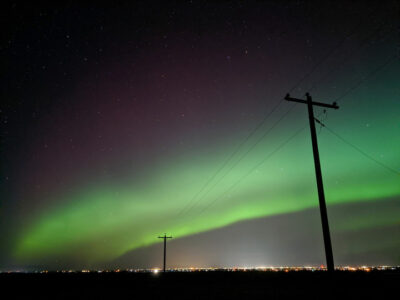Solar flare colours the night sky with northern lights
By Herald on October 12, 2021.
 Photographer Darren Ellingson captured the display of the aurora borealis earlier this week over southern Alberta. Photo Courtesy Darren Ellingson
Photographer Darren Ellingson captured the display of the aurora borealis earlier this week over southern Alberta. Photo Courtesy Darren EllingsonTim Kalinowski – Lethbridge Herald
A geomagnetic storm triggered by a solar flare (more formally known as a Coronal Mass Ejection) lit up the Earth’s northern hemisphere with a magnificent northern lights display on Monday.
Locke Spencer, an associate professor and Canada Research Chair, Tier 2, in Astrophysics at the University of Lethbridge, explains how a solar flare resulted in the powerful aurora borealis show seen Monday night.
“Sometimes what can happen is there are magnetic fields that originate on part of the sun on the surface and terminate somewhere else (on the sun),” he says. “(As) The sun is rotating and doing its thing these magnetic fields can get twisted, and now and then the fields kind of snap. Depending on what’s going on it can kind of collapse back into the sun or sometimes it can actually trigger a big genesis of material that’s ejected. And sometimes that material is ejected toward the Earth. Then that is called a Coronal Mass Ejection.”
Particles and ionized matter are then sent speeding into space at speeds between 250 km/s and 3,000 km/s, says Spencer, and if they happen to be ejected in the direction of Earth they will take between 15 hours to over 200 hours to arrive. The solar flare which triggered Monday’s solar storm actually occurred on Saturday, confirms Spencer, but took a few days to reach Earth.
When those highly energized particles arrive, they are generating their own magnetic field which collides with the Earth’s magnetic field, and the two forces colliding create the auroras we see in the sky.
“As those (ejected) particles fall through the atmosphere, and they interact with our magnetic field, and typically go to the North Pole,” he says. “So we see the glowing aurora as the excitation of our atmosphere as it is being hit with this initial solar matter.”
And while Monday’s solar storm was fairly mild by the standards they are measured by, (NASA confirms it was a G2 Solar Storm on a scale where G5 is the most severe), other more massive solar storms have the potential to wreak havoc on Earth’s electrical grid and satellite systems.
The most famous is recent history is what is known as the Carrington Event which took place in 1859. A massive solar flare triggered a geomagnetic storm which lit up the entire northern hemisphere as far south as Cuba, and blew out telegraph systems throughout the world.
It is a concern for the future, acknowledges Spencer, if such an event happens in our modern times where we have become so much more dependent on satellites and other electrical technologies than those in Victorian times were.
“There are papers out there saying if the wrong sort of solar storm hit us then it could be quite catastrophic,” he states. “Some of our electrical grid infrastructure is susceptible to these solar storms.”
But, Spencer confirms, he is aware of no such severe effects during this week’s solar event, and its main impact seems to have been giving those watching the night sky a great light show.
“It is just fascinating that nature puts on such a show for us,” he says. “We understand them a lot more than we did several years ago. And we are still, in some sense, vulnerable to these things taking place. But for the most part it is fairly harmless, and it’s just putting on a show. This one was quite profound in just the vast area of geography where people were able to observe.”
Follow @TimKalHerald on Twitter
15-14




